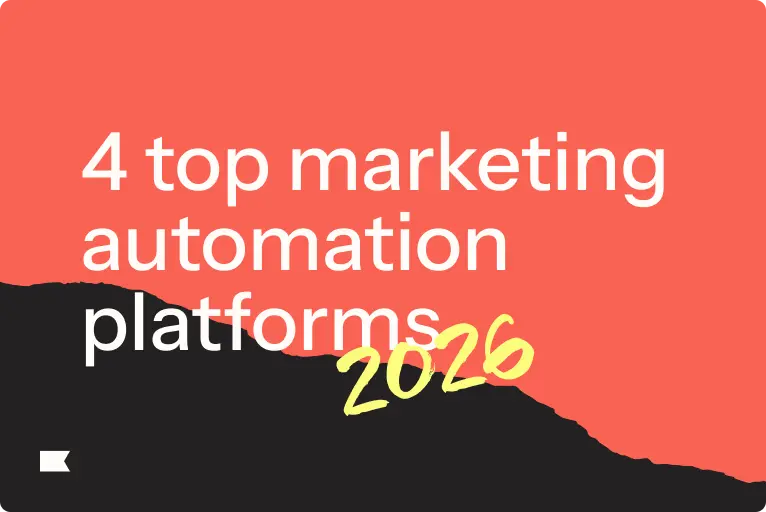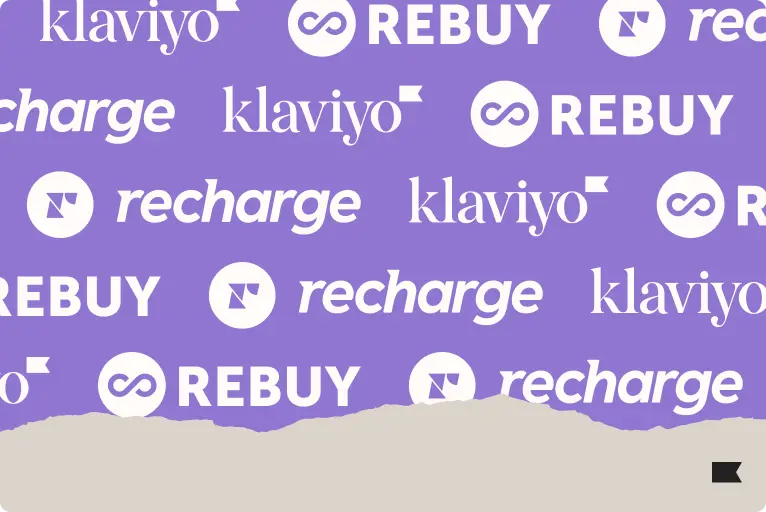When Mailchimp couldn’t measure up, Klaviyo’s data engine yielded profound results for these 5 brands
Everyone understands the importance of zero- and first-party data, and that using it to segment your audience and craft personalized messages is crucial.
But what separates the pros from the rookies is the agility and effectiveness of your toolset.
Let’s face it: if you’re stuck in front of your screen all day manually tagging individual subscribers to place them into rudimentary categories, your marketing plan’s growth will be slow—and frustrating.
Klaviyo’s seamless, automated data collection makes it easy to understand your customers on a holistic level—and use that understanding immediately to send more relevant messages.
“The ability to maximize segmentation within flows is really what sets Klaviyo apart from Mailchimp,” says Mindy Regnell, head of market intelligence at Klaviyo. Klaviyo’s new AI is “so unique and it’s ready to use, while Mailchimp’s is still in beta,” she says. “You can easily create a segment by typing a description of the people you want to reach. Then, you can see the segment definition and the number of subscribers in that segment, and adjust as needed.”
The ability to maximize segmentation within flows is really what sets Klaviyo apart from Mailchimp.
But you don’t have to take our word for it. Just ask some of the 35K+ brands that outgrew Mailchimp and made the switch to Klaviyo.
Here’s what a few of them had to say.
1. Hedley & Bennett ditches Mailchimp’s surface-level segmentation for Klaviyo’s precision
For years, culinary brand Hedley & Bennett was on Mailchimp to manage their email marketing. But as they grew into a multi-million-dollar business and diversified their offerings, their audience diversified, too. The team found that Mailchimp simply didn’t have the segmentation capabilities to serve their ever-growing, dynamic, multi-channel audience.
In 2018, Hedley & Bennett made the transition to Klaviyo and introduced SMS as a channel—which made it easier to differentiate between their target audiences. They created separate B2B and DTC segments and then specific sub-segments, like grillers, browsers who have yet to make a purchase, or folks who bought for a certain holiday.
The ability to create a new segment in 5 minutes is “critical,” says director of marketing Alice Khabituyeva. With Klaviyo’s segments AI, you can create segments in mere seconds.
Now, the brand uses Klaviyo to achieve things they just couldn’t do with Mailchimp. For instance, they created a waitlist in Klaviyo for their first chef’s knife. After promoting it via email, paid digital, and social, over 4K people signed up in less than 2 weeks to get early access to the knife on launch day.
One of their best moves has been giving customers the chance to sign up for email, SMS, or both. Founder Ellen Bennett says she sees a visible uptick in Shopify revenue after sending a new Klaviyo SMS campaign.
It’s no wonder—whereas Klaviyo’s segments update in real time, Mailchimp’s can take up to 2 hours. While segments in Klaviyo can be based on any combination of data, how you use segments is limited with Mailchimp. Plus, with Mailchimp, users rely on manually tagging customer profiles, which can eat your time.
Bennett adds, “If I could do it again, I definitely would’ve started with Klaviyo earlier.”
If I could do it again, I definitely would’ve started with Klaviyo earlier.
2. Club L trades in clunky data processing for powerful Klaviyo integrations
Club L is Britain’s go-to online store for women shopping for a glamorous outfit without busting their budget. The brand spent years generating revenue via social advertising and paid search, but as acquisition costs rose, they wanted to stop relying on third-party sites so much and pivot to owned marketing channels.
Club L tried to do this by forcing data into their Mailchimp account, but it just didn’t work. They needed a marketing platform that could turn subscriber data––including information about rewards and loyalty tiers––into powerful, personalized email and SMS messages.
With Klaviyo, they found just that.
Within a year of switching from Mailchimp to Klaviyo, Club L increased revenue contribution from email and SMS to 33%—mostly driven by their welcome series and abandoned cart flows.
Klaviyo’s deep ecommerce integrations sail right past Mailchimp’s, giving you the ability to sync third-party ecommerce events like subscriptions, shipping, helpdesk, and more.
Club L uses them to make the most of their data, with flows triggered based on events like a customer referring a friend or changing loyalty tiers.
Now, Club L can invite their highest-value customers to a secret sale by using loyalty data from LoyaltyLion to build segments. Using zero- and first-party data in Klaviyo to personalize their messages, they recommend outfits to subscribers based on what they’ve been browsing.
“Email marketing wasn’t a core part of our brand’s strategy until we onboarded with Klaviyo,” explains Steph Moorghen, digital marketing manager at Club L. “The ability to segment customers with personalized content in both email campaigns and automations has been pivotal.”
Email marketing wasn’t a core part of our brand’s strategy until we onboarded with Klaviyo. The ability to segment customers with personalized content in both email campaigns and automations has been pivotal.
Cat Jones, senior CRM executive, adds, “We’ve recently begun exploring SMS marketing, giving us more opportunity to target customers during peak trading periods and expand our database further.”
3. Klaviyo’s crystal-clear attribution brews success for Stone Brewing
Independent craft beer empire Stone Brewing began in the 90s with a humble dream—to disrupt the industrialized beer scene. Today, the business has expanded to encompass 7 taprooms, a network of retailers spanning the entire US and 40+ countries, and an online store.
With so many sales channels, reliable attribution is key to understanding revenue and losses. When Stone Brewing’s online and merch store started lagging, they realized their tech stack with Mailchimp just wasn’t seamless enough, making it harder to single out the problem.
Once they switched to Klaviyo, the Stone Brewing team was able to connect GoTab, the restaurant commerce platform they use in their brick-and-mortar locations, along with their website and ecommerce platform. This allowed them to differentiate retail and online superfans and message them accordingly.
The result was stunning: 62.8% YoY growth in revenue from Klaviyo flows as of September 2023.
And the attribution is crystal clear, thanks to Klaviyo’s customizable last-click attribution that shows you the specific items users buy after clicking an email link. Kelsey Vonk, Stone Brewing’s email marketing lead, says, “It’s been great being able to see more actionable metrics with Klaviyo.”
It’s been great being able to see more actionable metrics with Klaviyo.
4. Parts Avatar revs up success with Klaviyo’s sophisticated segmentation
Parts Avatar is Canada’s largest online auto parts store, and they also have two brick-and-mortar locations, with more on the way. In order to keep their customers up to date on deals and new locations, their email marketing program has to be agile—and fast.
Mailchimp was presenting Parts Avatar with problem after problem. First, segmentation took too long. The team had to refresh their audience segments before each usage, which sometimes took up to 10 minutes. This made it hard to send post-purchase recommendations aimed at specific segments or see which segments a customer was a part of at a given time.
Plus, Mailchimp only offered transactional emails through Mandrill, a separate app that the Parts Avatar team found too slow. They found a workaround—to run transactional emails on AWS—but channel-level reporting was still a problem.
Sandip Chaudhuri, VP of product marketing at Parts Avatar, says, “We wanted a full overview of the customer, but that wasn’t available in Mailchimp at all.”
So, they made the switch to Klaviyo—and gained several abilities they didn’t have in Mailchimp.
Parts Avatar can now:
- Combine first- and third-party data, including all event data from their custom platform.
- Create a segment of VIPs with the highest order frequency and forecasted total CLV, so the Parts Avatar customer support team can give their tickets priority.
- Segment by predicted CLV—Parts Avatar found that their segment of self-identified mechanics had a much higher CLV than DIYers, so they created separate strategies for those groups.
- Automate personalized flows of post-purchase product recommendations that go out on a rolling basis.
“All of the predictions and personalizations are helping us tremendously,” Chaudhuri says. “Without Klaviyo, we would struggle to offer our customers up-to-date, relevant information, and our pace would slow.”
Without Klaviyo, we would struggle to offer our customers up-to-date, relevant information, and our pace would slow.
5. Pinter raises the bar with Klaviyo’s personalization
Pinter, a UK company that makes home brewing doable (and fun) for people without experience, started using Mailchimp in 2020. The problem? Data was coming in, but they couldn’t use Mailchimp to inform the customer experience how they wanted to.
Switching to Klaviyo helped the Pinter team centralize their customer data into a single customer view.
The switch didn’t just make Pinter’s data more actionable. Klaviyo’s integrations also help the team gather it from various places:
- The store
- Their app
- Their customer advocacy program
- Quizzes
Leveraging data from such different sites allows the Pinter team to personalize customer journeys, which is crucial for scaling. Their welcome flow uses trigger splits, making sure readers aren’t prompted for an action they’ve already taken. When they launch a new brewing device, they segment specific targets based on purchase history and the Pinter model a customer already owns.
“Klaviyo’s easy-to-implement personalization allowed our launch to be completely customer focused, landing the right messages to the right customers at the right times,” says Matt Davis, senior retention and loyalty manager at Pinter.
Klaviyo’s easy-to-implement personalization allowed our launch to be completely customer focused, landing the right message to the right customers at the right times.
And the results are jaw-dropping: nearly 60% of customers sign up for a monthly subscription, over 65% download their app, and 10% buy a second Pinter. A whopping 36% of the brand’s revenue can be attributed to email and SMS marketing.
Switching from Mailchimp to Klaviyo FAQs
Here are the essentials:
Why do so many brands leave Mailchimp for Klaviyo?
Over 35K brands have left Mailchimp.com for Klaviyo because Klaviyo is more tailored to ecommerce and retail marketing, whereas Mailchimp is built for broad, general use. Klaviyo’s segmentation, templates, automated emails,, pop-ups, and reporting are more advanced than Mailchimp’s, too. Read a more detailed comparison report here.
What are some of the benefits of using Klaviyo for marketing?
Klaviyo has 300+ ecommerce integrations and marketing automations for email, SMS, mobile push notifications and reviews. It also has advanced reporting functionality and flexible pricing.
Is it easy to switch from Mailchimp to Klaviyo?
Yes! It only takes four key steps to save you time. Read how to migrate step by step in our Help Center.

Related content

Discover the best marketing automation platform for 2026 and learn how to choose based on data, integrations, scalability, and the features that drive real customer value.

Discover 4 proven ways to reduce cart abandonment and recover lost sales. Learn how to build trust, streamline check-out, and personalize abandoned cart flows to convert more shoppers.

Looking for the best Shopify apps for marketing and customer service? Klaviyo, Rebuy, and Recharge together create a high-performing tech stack that revenue and customer retention.